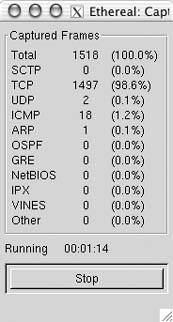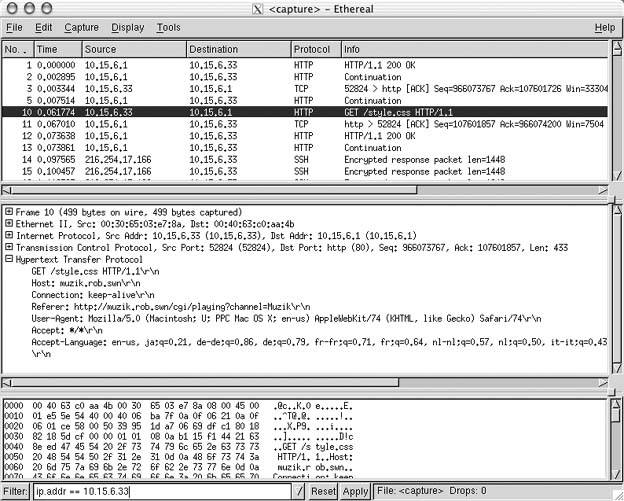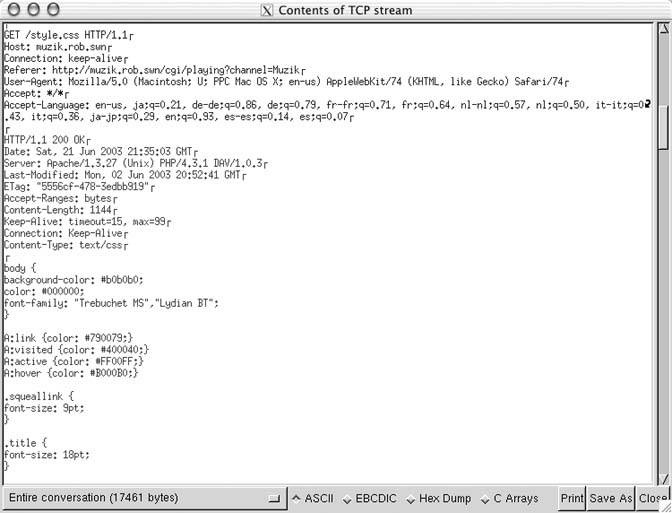Hack 31. Analyze Traffic with Ethereal


Sift through network data with one of the most advanced protocol analyzers available.
Ethereal is one of the most popular protocol analyzers on the planet. It runs on all major platforms, including Linux, BSD, Mac OS X, and Windows. Like tcpdump [Hack #33], it can capture packets directly from a network interface, or analyze data from a previously saved file.
Linux users can install the ethereal and ethereal-gnome packages using your distribution's package manager. BSD users can get ethereal from the packages or ports repositories depending on your BSD flavor. The Ethereal web pages at http://www.ethereal.com/download.html provide installers for Windows and Solaris, pointers to binary installers for many other operating systems, as well as the source code should you feel inclined to do some compiling.
While capturing data, Ethereal can give you real-time statistics about which protocols are actively in use (Figure 2-33). Start capturing by selecting Capture images/U2192.jpg border=0> Start…, select the interface you want to capture from, and click OK. Note that you need proper permissions (typically root privileges) to actually capture data.
If you would like to see these statistics again, with even more detail, after you have finished capturing packets, go to Tools  Protocol Hierarchy Statistics. You can use this on previously captured dump files as well. If you already have some captured data you can simply click File
Protocol Hierarchy Statistics. You can use this on previously captured dump files as well. If you already have some captured data you can simply click File images/U2192.jpg border=0> Open…and select the file youd like to analyze.
Ethereal displays the data it has collected in three ways. The top part of the window shows a summary of the data, with one packet per line. This lists the sequence, time, IP data, protocol, and general description of the packet. The data can be sorted on any of these fields by clicking the field name at the top. Selecting one packet displays more information in the other two window areas. The middle part of the window shows a hierarchical dissection of the packet, including the Ethernet, IP, TCP, and other layers. This allows you to quickly "drill down" into the particular piece of the packet that you are interested in. The bottom portion of the window shows a hex dump of the actual packet. Bits of the packet are automatically highlighted by selecting parts of the packet in the middle section. For example, selecting the IP source address in the middle section highlights the corresponding 4 bytes in the hex dump at the bottom.
Figure 2-33. Ethereal providing statistics while capturing

Figure 2-34 shows Ethereal's ability to dissect high-level protocols such as HTTP. Select an HTTP packet at the top, and open the Hypertext Transfer Protocol drop-down in the middle section. This shows the contents of the packet in plain ASCII.
Of course, most TCP conversations are spread across several packets. Ethereal reassembles the entire stream for you by selecting one packet and clicking Tools images/U2192.jpg border=0> Follow TCP Stream. Figure 2-35 shows the results of following the previous HTTP stream.
It is difficult to tell in black and white, but the two conversations are actually displayed in different colors, making it simple to tell at a glance which side is speaking.
Speaking of colors, Ethereal can even display its packet data with color coding, defined by a rich pattern-matching language. This can make any data you are searching for leap out in bold red while showing everything else in pale gray, for example. It uses the same pattern-matching language to specify display filters, which unfortunately isn't the same language used by tcpdump. For an example of how to build a display filter in Ethereal, see "Track 802.11 Frames in Ethereal" [Hack #32].
Figure 2-34. Ethereal decoding of an HTTP packet

Figure 2-35. Ethereal reassembling a TCP stream

This is just a simple demonstration of Ethereal's basic features. It can show you as much detail as you care to know about the packets flying around on your wireless network, and is one of the most powerful tools available for tracking down network problems. See the documentation and example capture files at http://www.ethereal.com for some other creative uses for Ethereal.
Bluetooth, Mobile Phones, and GPS
- Hacks 122: Introduction
- Hack 1. Set Up Bluetooth on Linux
- Hack 2. Set Up Bluetooth on Windows XP
- Hack 3. Connect Mac OS X with a Bluetooth Phone
- Hack 4. Connect Linux with a Bluetooth Phone
- Hack 5. Connect Windows XP with a Bluetooth Phone
- Hack 6. Use Your Treo as a Modem
- Hack 7. Send SMS from a PowerBook
- Hack 8. Remote Control Mac OS X with Bluetooth Phones and PDAs
- Hack 9. Remote Control Linux with a Bluetooth Phone
- Hack 10. Control XMMS with Bluetooth
- Hack 11. Liven Up Parties with a Participatory Slideshow
- Hack 12. Send SMS from Linux
- Hack 13. Remote Control Windows with Bluetooth Phones and PDAs
- Hack 14. Control Your Bluetooth Phone with FMA
- Hack 15. Control Your Computer from Your Palm
- Hack 16. Control Your Home Theater from Your Palm
- Hack 17. Choose a Cellular Data Plan
- Hack 18. Blog from Your Mobile Phone
- Hack 19. Get Google Maps on Your Mobile Phone
- Hack 20. Share Your GPS
- Hack 21. Broadcast Your GPS Position
- Hack 22. Map Wi-Fi Networks with Kismet and GPSd
Network Discovery and Monitoring
- Hacks 2339: Introduction
- Hack 23. Find All Available Wireless Networks
- Hack 24. Discover Networks with NetStumbler
- Hack 25. Detect Networks with Handheld PCs
- Hack 26. Find and Join Wireless Networks with AP Radar
- Hack 27. Detect Networks on Mac OS X
- Hack 28. Scan Passively with KisMAC
- Hack 29. Detect Networks with Kismet
- Hack 30. Monitor Wireless Links in Linux with Wavemon
- Hack 31. Analyze Traffic with Ethereal
- Hack 32. Track 802.11 Frames in Ethereal
- Hack 33. Watch Network Traffic
- Hack 34. grep Your Network
- Hack 35. Check Wi-Fi Network Performance with Qcheck
- Hack 36. Estimate Network Performance
- Hack 37. Get Real-Time Network Stats
- Hack 38. Graph Your Wireless Performance
- Hack 39. Find Radio Manufacturers by MAC
Wireless Security
- Hacks 4051: Introduction
- Hack 40. Stop Moochers from Stealing Your Wi-Fi Bandwidth
- Hack 41. Visualize a Network
- Hack 42. Secure Your Linux Network with WPA
- Hack 43. Control Wireless Access by MAC
- Hack 44. Authenticate Wireless Users
- Hack 45. Forward Ports over SSH
- Hack 46. Proxy Web Traffic over SSH
- Hack 47. Securely Connect Two Networks
- Hack 48. Generate a Tunnel Configuration Automatically
- Hack 49. Poll Wireless Clients
- Hack 50. Interrogate the Network
- Hack 51. Track Wireless Users
Hardware Hacks
- Hacks 5262: Introduction
- Hack 52. Add an External Antenna
- Hack 53. Do-It-Yourself Access Point Hardware
- Hack 54. Boot from a Compact Flash Hard Drive
- Hack 55. Increase the Range of a PowerBook
- Hack 56. Send Power over Your Ethernet
- Hack 57. The NoCat Night Light
- Hack 58. Upgrade the Linksys WET11
- Hack 59. Scan for Wireless Networks Automatically
- Hack 60. Backlight Your Zipit
- Hack 61. Unwire Your Pistol Mouse
- Hack 62. Mobilize Your WRT54G with the WiFiCar
Software Hacks
- Hacks 6382: Introduction
- Hack 63. Build Your Own Access Point with Linux
- Hack 64. Bridge Your Linux AP
- Hack 65. Protect Your Bridge with a Firewall
- Hack 66. Filter MAC with HostAP and Madwifi
- Hack 67. Upgrade Your Wireless Router
- Hack 68. Set Up an OLSR Mesh Network
- Hack 69. Extend Your Wireless Network with WDS
- Hack 70. Pebble
- Hack 71. Wall Off Your Wireless
- Hack 72. Run Your Mac as an Access Point
- Hack 73. Run Linux on the Zipit Wireless Messenger
- Hack 74. Capture Wireless Users with NoCatAuth
- Hack 75. Capture Wireless Users on a Small Scale
- Hack 76. Build an Online Community in Your Offline Neighborhood
- Hack 77. Manage Multiple AirPort Base Stations
- Hack 78. Advertise Bonjour Services in Linux
- Hack 79. Advertise Any Service with Bonjour in Mac OS X
- Hack 80. Redirect Brought to you by Bonjour Ads
- Hack 81. Use a Windows-Only Wireless Card in Linux
- Hack 82. Use Your Orinoco Card with Hermes AP
Do-It-Yourself Antennas
- Hacks 8393: Introduction
- Hack 83. Make a Deep Dish Cylindrical Parabolic Reflector
- Hack 84. Spider Omni Antenna
- Hack 85. Pringles Can Waveguide
- Hack 86. Pirouette Can Waveguide
- Hack 87. Primestar Dish with Waveguide Feed
- Hack 88. Primestar Dish with Biquad Feed
- Hack 89. Cut a Cable Omni Antenna
- Hack 90. Build a Slotted Waveguide Antenna
- Hack 91. The Passive Repeater
- Hack 92. Determine Your Antenna Gain
- Hack 93. Build Cheap, Effective Roof Mounts
Wireless Network Design
- Hacks 94100: Introduction
- Hack 94. Analyze Elevation Profiles for Better Long-Range Wireless Networking
- Hack 95. Build a Wireless Network for the Large House
- Hack 96. Establish Line of Sight
- Hack 97. Calculate the Link Budget
- Hack 98. Align Antennas at Long Distances
- Hack 99. Slow Down to Speed Up
- Hack 100. Take Advantage of Antenna Polarization
Appendix A. Wireless Standards
- Appendix A. Wireless Standards
- Section A.1. 802.11: The Mother of All IEEE Wireless Ethernet
- Section A.2. 802.11a: The Betamax of the 802.11 Family
- Section A.3. 802.11b: The De Facto Standard
- Section A.4. 802.11g: Like 802.11b, only Faster
- Section A.5. 802.16: WiMAX Long Distance Wireless Infrastructure
- Section A.6. Bluetooth: Cable Replacement for Devices
- Section A.7. 900 MHz: Low Speed, Better Coverage
- Section A.8. CDPD, 1xRTT, and GPRS: Cellular Data Networks
- Section A.9. FRS and GMRS: Super Walkie-Talkies
- Section A.10. 802.1x: Port Security for Network Communications
- Section A.11. WPA & 802.11i
- Section A.12. BSS Versus IBSS
Appendix B. Wireless Hardware Guide
EAN: 2147483647
Pages: 178
